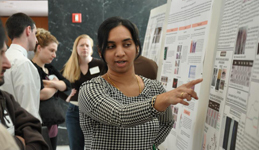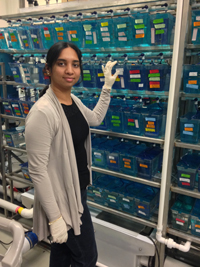Jayalakshmi Govindan
As a doctoral student, Jayalakshmi Govindan (SX 2013) is investigating how zebrafish regenerate their fin skeletons in the hopes of one day making this type of bone regeneration possible for humans.
Tell us about your educational background.
I received my master of science and master of philosophy degrees in microbiology in India. Currently, I am a fourth-year graduate student in the Department of Biological Sciences at Lehigh University in Bethlehem, Pennsylvania. I am pursuing a PhD in the field of molecular biology.
philosophy degrees in microbiology in India. Currently, I am a fourth-year graduate student in the Department of Biological Sciences at Lehigh University in Bethlehem, Pennsylvania. I am pursuing a PhD in the field of molecular biology.
In my lab, we study the role of Cx43 (a gap junction protein that facilitates direct cell-cell communication) during bone regeneration and skeletogenesis. We use zebrafish as a model system for its remarkable ability to regenerate several of its body parts including the tail fin that are made up of bony fin rays.
Mutations in the cx43 gene result in reduced tail fin length in zebrafish. Interestingly, mutations in human CX43 also result in defective skeletal morphogenesis, revealing that the function of Cx43 is highly conserved. We are interested in understanding how defects in gap junctional communication leads to defects in bone growth and identifying the underlying genetic and molecular pathways.
Do you have a particular teacher or professor who inspired your love of science?
I am excited to show my gratitude to my teachers who have played an important role in my career. Dr. Shobana was my biology teacher from 8th grade to high school and her unique way of teaching helped me to understand and remember important concepts very well. I am pretty sure that she was the person who instilled admiration and liking toward biology in me.
During my master's degree at Madras University, India, Dr. R. Balasubramanian's lectures on protein technology and his exams were designed so well that anybody would fall in love with that subject. He was definitely a great inspiration for me to pursue a career in the field of molecular biology. But there are several others who have inspired me at different time periods throughout my career.
What is the focus of your current research?
Our lab has shown that Cx43 plays a dual role during skeletal growth in regenerating zebrafish fin. It regulates both cell proliferation and joint formation. I am working with a gene called hapln1a which I have shown to function downstream of cx43 to promote its function. It codes for an extracellular matrix protein (ECM) protein and is an important component of the ECM. My work is to study the mechanism by which Hapln1a is mediating Cx43-dependent phenotypes.
dual role during skeletal growth in regenerating zebrafish fin. It regulates both cell proliferation and joint formation. I am working with a gene called hapln1a which I have shown to function downstream of cx43 to promote its function. It codes for an extracellular matrix protein (ECM) protein and is an important component of the ECM. My work is to study the mechanism by which Hapln1a is mediating Cx43-dependent phenotypes.
Tell us about something we might see in our daily lives that directly correlates to your work.
Tailed amphibians like newt and salamander are capable of regenerating limbs, tails, jaws, eyes, and a variety of other internal organelles. Likewise, zebrafish are capable of regenerating a variety of organs. Basically, when there is a wound or amputation, the cells in the wounded area become activated and start to remodel tissues and organs back to the normal existing state. But in the case of humans, the body reacts by covering that wound site with thick scar tissue to prevent infection.
In the comics, Spider-Man, the scientist Curt Connors injects himself with a lizard’s serum to regrow his amputated arm. He turns out to be an evil humanoid-lizard. Despite the side effects, the story actually reflects a genuine and long standing scientific question: “Can these extraordinary regenerative powers of animals be mimicked in humans?
Give us an example of how multi-disciplinary research directly contributed to your work.
Even though I am studying the skeletal morphogenesis in a regenerating zebrafish tail fin, which is a field of developmental biology, our lab utilizes an array of molecular biology techniques to study gene expression patterns. Our lab also utilizes cell culture techniques, such as zebrafish fibroblast cell lines, to test various hypotheses under in vitro conditions. We also utilize various microscopy techniques and computational software for microscopy image analysis. The very nature of the work in our lab is a multi-disciplinary approach.
What are your thoughts on the future of STEM education?
A nation's future prosperity depends on, and is in fact directly linked to, STEM education for all students. Science, technology, engineering, and mathematics education is the basic building block for students to be successful throughout their careers, right from school and then college and work. Awareness about STEM education should be promoted rapidly and the government should take measures to elevate the urgency regarding the advancement in STEM education and make significant modifications across education systems
Describe your patent/publishing experience.
I do not have a patenting experience, but I recently published my first paper. Although publishing a paper is not a smooth process, it's definitely truly a great learning experience. It requires a lot of patience and writing skills, which I believe will become faster and improve with experience. I believe getting a publishing experience early in the career will help a lot. Publishing a paper also depends on the reviewers and their extent of expertise in our field to understand and critique the work.
What has the honor of induction to Sigma Xi meant to you?
I feel delighted and lucky to be a part of this scientific association. Sigma Xi has played an important role in increasing my awareness about diversity of research and the beauty of this diversity. It is practically impossible for a single person to do anything. Sigma Xi has made me realize how the scientific community helps to exchange ideas, build strategies, and work together to leverage continuous advancement in science and technology. Personally, the funding for my project from Sigma Xi’s Grants-in-Aid of Research program has increased my self-confidence.
Has Sigma Xi helped further your career?
Sigma Xi has increased my awareness about being an active researcher. Becoming a member of Sigma Xi has motivated me to take part in promoting STEM education by participating in volunteer activities and also increasing the awareness among school students regarding science and research.
When you're not working on your research, what do you do in your free time?
As a mother of a 6-year old daughter, during free time mostly I like to spend time with my family and friends, but I also like to do painting and gardening!
What's your favorite movie?
"Three Idiots" (Hindi Movie)
What is your favorite motto?
My two favorite mottos by Robin Sharma are: (1) "Every challenge is nothing more than a chance to make things better" (2) "Your I CAN is more important than your IQ."
What advice would you give to a young researcher just starting out in your field?
As a researcher working in a molecular biology lab, my first advice to a new person starting in my field is, be your worst critique and pay attention to every small detail and understand the basics and principles behind every step in an experiment. This in turn makes trouble shooting easier and faster which in turn will save more time and resources.
What advances do you see in your field of research over the next 125 years?
Whenever I try to explain bone regeneration or regenerative medicine to someone, the first question that arises is: "Is it possible to make humans regenerate a body part if it is damaged (like liver or kidney) or lost (like an amputated limb or a toe or a finger)? Or will it be as tedious as an organ transplant?" This in fact, shows how exciting regenerative medicine is for the public.
I think that therapies involving regenerative medicine are already in use on a small scale and for a few specific kinds of treatment such as cell-based therapies to stimulate the process of healing, use of organs engineered in a lab, use of biologically compatible materials to induce tissue regeneration from within the body and skin, and cartilage replacements. Regenerative medicine research is widespread across the globe and with advancements in the field of genetics, cell biology, nanotechnology, and biomaterial engineering, new potentials unwrap for what could be achieved. In another 125 years, I envision that regulation of bone regeneration with strategies that exactly mimic the normal cascade of events during bone formation will be established and will not be a question outside the realm of possibility anymore.
About the Meet Your Fellow Companion series
Sigma Xi's motto is the Greek "Spoudon Xynones," or "Companions in Zealous Research." With that thought in mind, we like to highlight "Fellow Companions" to learn more about their work and what the honor of induction to Sigma Xi has meant for their careers. The articles are published in the Sigma Xi Today section of American Scientist and here on the website. Editor's note: Proteins may have the same name as genes. Human genes are written with capitalized letters and italicized. Fish genes are lowercased and italicized. The first letter for a protein is capitalized but the word is not italicized.